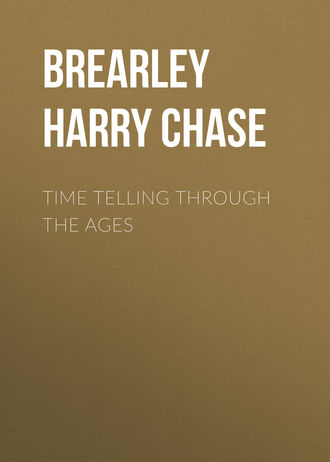 полная версия
полная версияTime Telling through the Ages
Nuremberg – A German city where Peter Henlein made the first watch. It was one of the chief clock centers of the 16th and 17th centuries and with Augsburg and Ulm supplied the markets of Europe with the first small clocks.
Nuremberg Eggs – Watches made in Nuremberg in the shape of eggs. If not the first watches at least very early examples.
Obelisk – A square shaft with a pyramidal top. The ancient Egyptian obelisks are thought to have served as gnomons.
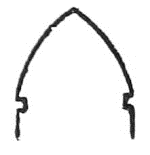
Ogive – A pointed arch – of the architectural type known as Gothic.
Oil Sink – The cavity around the pivot hole in watch and clock plates, designed to hold a small particle of oil in contact with the pivot.
Ormolu – Gilt or bronzed metallic ware, or a fine bronze which has the appearance of being gilded. Used for ornamenting the cases of fine old clocks.
Orologe – An obsolete form of horologe. See Horologe.
Orologiers – An obsolete form of horologers, a term not now in use but signifying men who constructed time-pieces.

Orrery – A planetarium; an instrument showing the relative motions, positions and masses of the sun and planets. It was so named from Lord Orrery, for whom the first modern planetarium was made in England.
Oscillation – The movement back and forward of a pendulum or the swing of a balance spring. The vibration.
Overbanking – Pushing of the ruby pin past the lever, caused by excessive vibration of the balance. In a cylinder escapement the turning back of the cylinder until an escape wheel tooth catches and holds it. In a chronometer escapement the second unlocking of the escape wheel from the same cause.
Overcoil – The outermost coil of a Breguet spring which is bent back across the coil toward the center.
Pacificus – Archdeacon of Verona, died about 850 A.D. It is claimed by some that he made a clock furnished with an escapement. (Bailly.) But this is not proved, and others believe it to have been merely a water-clock.
Pad – The pallet of the anchor escapement for clocks.
Pair Case – At one time watches were made with two or even three separate cases. The outer one of shagreen tortoise shell, or some other ornamental material was sometimes for the protection of the delicate enamel on the inner case. Sometimes as in the case of repeaters the inner case was pierced to emit the sound. Then the outer one served as dust protection to the works.
Palladium – A soft metal formerly used in alloy with copper and silver for the balance and balance spring of non-magnetizable watches. Too soft to be as serviceable as steel, it has been superseded by a platinum alloy.
Pallet – Has different meanings, even among watchmakers. Generally, the part through which the escape wheel gives impulse to the balance or pendulum.
Pallet Staff – The arbor on which the pallet is mounted, and on which it turns.
Pallet Stone – The jewel on the contact face of the pallet, where it is struck by the teeth of the escape wheel.
Parallax – The apparent angular displacement of a heavenly body due to a change of the observer's position.
Pedometer – An instrument which registers the number of paces walked – hence if properly adjusted to the length of step of the wearer it gives the distance traversed.
Pendant – The small neck and knob of metal connecting the bow of a watch case with the band of the case.
Pendulum – A body suspended by a rod or cord and free to swing to and fro; used in clocks to regulate the velocity with which the driving power moves the wheels and hence the hands. The isochronism of a pendulum vibrating in a cycloidal arc was first discovered by Galileo but he did not apply it to clocks. Most authorities credit Christian Huyghens with that adaptation to instruments for keeping time. The pendulum was first suspended by a silk cord and thus vibrated in a circular instead of cycloidal arc. "Huyghens' Checks" were an unsuccessful attempt to remedy this. Dr. Hooke succeeded in remedying it by suspending the pendulum by a flat ribbon of spring steel.

Pendulum, Gridiron – Invented by Harrison in 1726, and still with slight improvements an effective timekeeper. The rod of this pendulum is constructed of five steel and four brass rods so arranged that those which expand most are counteracted by those of less expansion, and the length of the pendulum remains constant.
Pendulum, Mercurial Compensation – A pendulum having for a bob a jar of mercury which expands upward with the increase of temperature thus counteracting the lengthening of the rod from the same cause. Invented by Graham about 1720. With slight improvements still in use and keeps time very accurately.
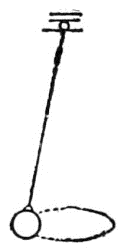
Pendulum, Torsion – A pendulum vibrating by the alternate twisting and untwisting of an elastic suspension. The body is a horizontal disc weighted around its edges, and its suspension a steel or brass wire. The period of a torsion pendulum being much longer than a vibrating pendulum of the same length, the time of running is longer. Clocks fitted with torsion pendulums have run a year on one winding.
Pendulum Swing – The short ribbon of spring steel which suspends the pendulum of a clock.
Penetration of Gearing – The depth of intermeshing of the teeth of pinion and wheel.
Phillips Spring – A balance spring with terminal curves after rules laid down by M. Phillips, an eminent French mathematician. A term seldom used though his curves are generally followed.

Pillar – The three or four short brass posts which keep the plates at their proper distance apart. In early days made in very artistic and elaborate shapes. Later they became plain straight cylindrical columns.
Pillar Model – A type of movement in which the works are hung between two plates supported and separated by posts or pillars and forming all the principal bearings of the movement. Only average adjustment is possible in this model. In this model the plate is sometimes cut away to imitate a "bridge model." The opposite extreme in construction to the "bridge model."
Pillar Plate – The lower plate of a watch movement – the one nearest the dial – to which the pillars are solidly fixed, in a "pillar model."
Pinchbeck, or "Pinchbeck Gold" – An alloy of three parts zinc to four of copper which "resembles gold in color, smell and ductility." So called from its inventor Christopher Pinchbeck (1670-1732) who during his life guarded the secret of its composition very jealously.
Pinion – The smaller of two toothed wheels that work together. The teeth of a pinion are called leaves. See also Lantern Pinion.
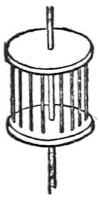
Pinion, Lantern – A pinion consisting of two circular metal plates joined by short steel wires.
Pitch – The length of the arc of the circumference of the pitch circle from center to center of two adjacent teeth.
Pitch Circle – The geometrical circle traced with the center of the wheel as its center and at which the curved tips of the teeth begin. The diameter is proportional to the number of teeth determined upon. The proportion of the pitch circles of a wheel and a pinion gearing together is determined by the ratio of revolutions desired.
Pitkin, Henry – With his brother, James F., he started at Hartford, Conn., in 1838, the first factory for machine-made watches in the United States. They made their own machinery, which was very crude. After making about 800 watches they were forced to abandon the project, being unable to compete with cheap foreign watches. He died in 1845.
Pivots – The ends of the rotating arbors in a watch that run in bearings.
Planetarium – An astronomical clock which exhibits the relative motions and positions of the members of the solar system. Has no regulating system and usually no driving power but is run by turning a crank by hand.
Plates – In watches and small clocks the circular discs of brass to which the mechanism of the watch is supported. In large clocks the plates are usually square-cornered oblong. See Pillar Plate, Top Plate, Half Plate, Full Plate, etc. In half-plate, and three-quarter-plate types of watches part of the disc is cut away.
Pocket Chronometer – A watch with a chronometer escapement.
Polos – A basin in the center of which the perpendicular staff or gnomon was erected, and marked by lines for the twelve portions of the sun-lit day. Herodotus ascribes its invention to the Babylonians, Phavorinus claims it for Anaximander and Pliny for Anaximenes. Also called "Heliotropion."
Potance or Potence – A vertical or hang down bracket, supporting the lower end of the balance staff in full-plate watches.
Prescot – A town in a remote part of Lancashire for years the center of the movement trade in England.
Push Piece – 1. The milled knob pushed in from the pendant to open the case. 2. The boss pushed in when the watch is to be set.
Quare, Daniel – 1649-1724 – Claimed the invention of the repeater, and backed by the Clockmakers' Company obtained the patent against Barlow from James II. Also credited with the invention of equation clocks. He was master of the Clockmakers' Company in 1708. He first used the concentred minute hand in England, but Huyghens had preceded him in this in the Netherlands.
Quarter – 1. A term in common use for the period of three months – a quarter of the year. 2. The fourth part of an hour – 15 minutes.
Quick Train – A watch movement balance vibrates 18,000 times per hour. Unequal mainspring pull is less felt in the quick train. Used generally in Switzerland and America, and a feature of practically all modern watches.
Rack – A straight bar, or segment of a circle, with teeth along one edge. It has a reciprocating motion.
"Radiolite" – Trade name adopted by Robt. H. Ingersoll & Brothers. for their watches having black faced dials with luminous hands and numerals. Composed of a substance in which genuine radium is used in minute proportions.
Radius of Gyration – The distance from the center of gyration to the axis of rotation.
Ramsey, Davis – One of the earliest British watchmakers of renown. He was appointed "keeper of clocks and watches" to James I, and appears to have retained his appointments after the death of the latter. He was the first master of the Clockmakers' Company tho he seems to have taken little active part in the management thereof. Scott introduces him into his story – "The Fortunes of Nigel" as a Keeper of a shop a few yards east of Temple Bar. Without doubt he was the leading clockmaker of his day. He died in 1655.
Ratchet – The pawl, or dog, which engages in the teeth of a ratchet wheel and prevents it from turning backward. It is held lightly against the periphery of the ratchet wheel by a small spring known as the ratchet spring.
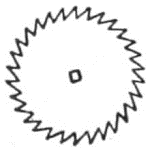
Ratchet Wheel – A wheel with triangular teeth fixed on to an arbor to prevent the latter from turning backward. The fronts of the teeth are radial, the backs straight lines running from the tip of one tooth to the base of the next. In going-barrel, keyless watches the ratchet has epicycloidal teeth. By "the ratchet" in a watch, chronometer or clock with mainspring is meant the ratchet fastened to the barrel arbor to prevent the mainspring from slipping back when it is being wound.
Recoil – In recoil escapements the pallets not only stop the escape wheel but actually turn it backward a slight distance. This backward motion is called the recoil.
Regulator – 1. A standard clock with compensated pendulum with which less accurate movements are compared. 2. The lever in a watch by which the curb-pins regulating the swing of the hairspring are shifted.
Remontoire – An arrangement in the upper part of the going train by which a weak spring is wound up or a small weight is lifted that gives impulse to the escape wheel at short intervals. Its use is to counteract the irregularities in impulse due to the coarse train, etc. They are delicate and complicated and now superseded by the Double Three-legged Gravity Escapement.
Repeater – A striking watch or clock which by the pulling of a string or the pressing of a button could be made to repeat the last hour and part hour, struck. In vogue during the 18th century. Credit for the invention was disputed by Daniel Quare and Edward Barlow. James II gave the decision in favor of Quare whose mechanism was a trifle simpler.
Repousse – A kind of chasing in which the metal is punched or pressed from the back bringing the design into higher relief than by the usual method of indenting.
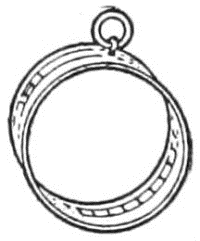
Ring-Dial – See Sun-dial, Portable.
Richard, Daniel Jean – A Swiss watchmaker, born at La Sagne in 1665. At fifteen a watch having come into his hands, he constructed a similar one unaided. That was the first watch made in Neuchatel. After a time in Geneva he set up business in La Sagne, afterwards moving to Locle. He created the watch industry of Neuchatel and saw it grow to a neighborhood of five hundred workers. He died at Locle 1741. In 1888 a bronze statue was erected to him there.
Robbins, Royal E. – Born in Connecticut 1824. He was essentially one of the "fathers" of American watchmaking because it was through his financing and clever management that the first watch company finally succeeded in making a financial success.
Roller – The circular plate in a lever escapement, into which the ruby pin is set.
Roller-Jewel – Same as "impulse pin."
Roman Indiction – A period of fifteen years appointed by the Emperor Constantine 312 A. D. for the payment of certain taxes.
Rose Engine – A lathe in which the rotary movement of the mandrel is combined with a lateral, reciprocating movement of the tool rest; used for ornamenting the outside cases of watches with involved curved engraving.
Ruby Pin – The impulse pin in a lever escapement, made of a ruby.
Ruby Roller – The roller in a duplex escapement against which the teeth of the escape wheel are locked.
Run – In the lever escapement, the extent of the movement of the lever toward the banking pins after the "drop" on to the locking.
Sabinianus – Pope from 604 to 606. Said to have invented a clock in 612 A. D., but the clock he is supposed to have built was probably only another of many forms of clepsydrae, or water clocks.
Safety Pinion – A center pinion in a going-barrel watch which allows the recoil of the barrel if the mainspring breaks.
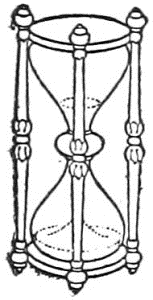
Sand-Glass – (Clepsammia) – A dumb-bell-shaped glass globe containing sand, and with a small aperture through which the sand flows in a certain fixed time. The most common form is the hour-glass but many others are in use as the three-minute glass for boiling eggs, the two-minute glass used by the British Parliament, etc. Dried and finely powdered eggshell sometimes used in place of sand. The principle is the same as that of the simplest form of clepsydra. See Hour-Glass.
Sandoz and Trot – A firm which established the first watch factory in Switzerland in 1804. Previous to that time watchmaking had been a house industry.
Second – One-sixtieth of a minute: 1-3600 of a mean solar hour.
Secondary Compensation – Same as "auxiliary compensation." See Auxiliary.
Seconds Hand – The hand on the dial of a clock or watch which revolves once a minute. Sometimes small and set in a small circle of its own. Sometimes long and traverses the whole dial. See Center-seconds and Sweep-seconds.
Seconds Pivot – The prolongation of the fourth wheel arbor to which the seconds hand of a watch is fixed.
Seconds, Split – Divided seconds – into quarters, or fifths; measured by a chronograph.
Shadow – A darkened space resulting from the interception of light by an opaque body.
Shagreen – Made from the tough skin that covers the crupper of a horse or ass. Rough seeds are trodden into the skin and then allowed to dry. The seeds are shaken out and the skin dyed green. Then the rough surface is rubbed down smooth leaving white spots on the green ground. Also made from the rough skin of sharks and dolphins. Formerly used a great deal for the outer cases of watches. See Pair Cases.
Sherwood, Napoleon Bonaparte – Born in 1823. About 1855 he entered the watchmaking business in the employ of the Waltham Watch Co. He revolutionized jeweling methods and invented among other things a "Counter-sinker," "End-shake tools," "Truing-up tools" and "Opener." In 1864 he organized the Newark Watch Company but within a few months severed his connection with it. He died in 1872.
Sidereal Time – The standard used by astronomers; measured by the diurnal rotation of the earth, which turns on its axis in 23 hours, 56 minutes, 4.1 seconds. The sidereal day is therefore 3 minutes, 56 seconds shorter than the mean solar day. Mean time clocks can be regulated with greater facility by the stars than by the sun for the motion of the earth with regard to the fixed stars is uniform. Clocks all over the United States are so regulated from the Naval Observatory at Washington.
Side-Shake – Freedom of pivots to move sideways. See End-Shake.
Slow Train – A train whose balance vibrates 14,400 times an hour. Now never used in pocket watches because of susceptibility to inequalities in the pull of the mainspring, jars, sudden movements, etc. Used, however, in marine chronometers.
Snail – A cam shaped like a snail, used generally for gradually lifting and suddenly discharging a lever, as in the striking mechanism of clocks.
Snailing – A method of ornamenting with circles and bars parts of a watch movement which it is not desirable to polish highly.
Solar Time – Time marked by the diurnal revolution of the earth with regard to the sun, of which the midday is the instant at which the sun appears at its greatest height above the horizon. This instant varies from twelve o'clock mean time because the earth also advances in its orbit and its meridians are not perpendicular to the ecliptic.
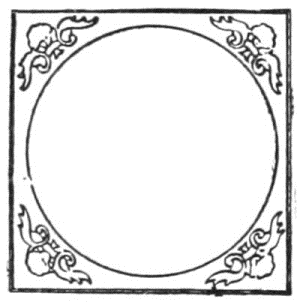
Spandrels – The corners of a square face outside the dial of a clock. Formerly very beautifully decorated. The age of the clock can be told approximately from the form of ornamentation employed.
Split Seconds – A chronograph in which there are two center-seconds hands – one under the other – which can be stopped independently of one another.
Spring-Clocks – Clocks whose driving power is a coiled spring instead of a weight.
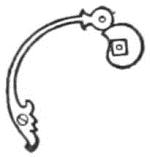
Stackfreed – The derivation of the word is obscure; it is possibly Persian. A device to counteract the difference in power of the mainspring at the different stages of its unwinding. Fixed to the mainspring arbor above the top plate is a pinion having eight leaves, which gears with a wheel having twenty-four teeth, which do not quite fill out the circumference of the wheel. Fastened to the wheel is a cam, concentric for about seven-eighths of its circumference and indented for the remainder. Into a groove in the concentric portion of the edge is pressed a roller which is pivoted at the free end of a strong curved spring. When the mainspring is fully wound the roller rests in the curved depression of the cam and the effort required to lift the roller up the incline absorbs some of the mainspring's power. On the other hand when the mainspring is nearly run down, the roller is descending an inclined plane and absorbs less of the power. Not an acceptable device and now rarely met with.
Stem-Winding – The ordinary method of winding keyless watches by means of a stem running through the pendant.
Stop Work – An arrangement for preventing the overwinding of a mainspring or a clock weight.
Stratton, N. P.– One of the early watchmakers connected with American manufacture. He was an apprentice of the Pitkin Bros., and was sent by the Waltham Company to England in 1852 to learn gilding and etching. He was made assistant superintendent of the Waltham Co. in 1857. He invented a mainspring barrel and a hair-spring stud which were later adopted by the Waltham Company.
Striking-Work – The part of a clock's mechanism devoted to striking. The chief forms are Rack, and Locking-plate, or Count-wheel. See separate articles.
Striking-Work, Locking-Plate, or Count-Wheel – Used in turret clocks where there is no occasion for the repeating movement. This form of striking work does not allow of the repetition or omission of the striking of any hour without making the next one wrong.
Striking-Work – Rack – A form of striking work used largely in house clocks; the number of blows to be struck depends merely on the position of a wheel attached to the going part. In this form the striking of any horn may be omitted or repeated without deranging the following strikes.
Stud – 1. A small piece of metal pierced to receive the outer or upper coil of a balance spring. 2. The holder of the fusee stop-work. 3. Any fixed holder used in a watch or clock, not otherwise named, is called a stud.
Style – The finger or gnomon on a sun-dial whose shadow, falling on the plate, indicates the time.
Sully, Henry – An English watchmaker of the early eighteenth century who lived most of his life in France. He presented the French Academy with a marine timekeeper superior to the timepieces of the period, and a memoir describing it. He died shortly afterward and advance in the art was delayed.
Sun-Dial – A device for telling time by the shadow of a style, cast by the sun, as thrown upon a disk or plate marked with the hour lines. Dials were named from their positions – equinoctial or equatorial; east; erect or vertical; horizontal; inclining, etc., or from their purpose or method of use, as portable, reflecting, etc., or as in the case of the ring-dial, from their form. The word is derived from the Latin dies. The style in the earliest dials was a vertical staff, but later it was found that reasonable accuracy could only be obtained by a style set parallel to the earth's axis – that is, inclined to the horizontal at the angle of latitude of the locality in which the dial was set.
Even before the first astronomical discoveries of the Babylonians, people had felt some need of a convenient device to mark and measure the passing of the time, especially the shorter divisions of recurring time, the time of day. Sunrise and sunset marked themselves by the horizon, but noon was harder to determine, and the points of mid-morning and mid-afternoon harder still. And with the knowledge of those regular movements in the heavens which determine time on earth, and with the closer division of the day into its hours, that need became a sheer necessity.
The obvious measure of the sun's movements was the moving shadow cast by the sun itself. And the earliest device for recording time was naturally the sun-dial. Its origin fades into the twilight of antiquity. Long before we know anything about him, primitive man measured the moving shadow of some tree. And it occurred to him to set up a post or pillar in some convenient place, and mark out the positions into which the shadow swung. The earliest sun-dials were of this pattern, with a vertical pointer of gnomon, and the hours marked upon the ground. And it is related of the early Greeks that they told the time individually by marking and measuring the length of their own shadows. But the measure of time by the length of a shadow is very irregular at best, because of the yearly motion of the sun. The shortest shadow of the day will indeed fall at noon. But that noon shadow will vary in length according as the sun's noon is high in Summer or low in Winter; and so the whole scale of lengths will be different for every day in the year. If a three foot shadow means mid-afternoon today, it will mean quite another time tomorrow. And for measuring by the direction of the shadow, the vertical gnomon is more irregular still. For the swing of the shadow would depend not only upon the sun's motion across the sky from East to West, but also upon his slant North and South along the sky. And this would change from day to day. The difficulty was to make a dial of which the shadow would move as regularly as the sun moves.

